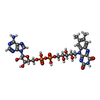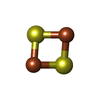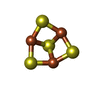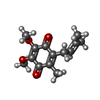+ Open data
Open data
- Basic information
Basic information
| Entry | Database: PDB / ID: 8gs8 | ||||||||||||
|---|---|---|---|---|---|---|---|---|---|---|---|---|---|
| Title | cryo-EM structure of the human respiratory complex II | ||||||||||||
 Components Components |
| ||||||||||||
 Keywords Keywords |  OXIDOREDUCTASE / OXIDOREDUCTASE /  succinate dehydrogenase / succinate dehydrogenase /  electron transport chain / electron transport chain /  human mitochondria / human mitochondria /  oxidative phosphorylation oxidative phosphorylation | ||||||||||||
| Function / homology |  Function and homology information Function and homology informationregulation of catecholamine secretion /  succinate dehydrogenase activity / succinate metabolic process / mitochondrial electron transport, succinate to ubiquinone / mitochondrial respiratory chain complex II, succinate dehydrogenase complex (ubiquinone) / succinate dehydrogenase (quinone) activity / : / Citric acid cycle (TCA cycle) / succinate dehydrogenase activity / succinate metabolic process / mitochondrial electron transport, succinate to ubiquinone / mitochondrial respiratory chain complex II, succinate dehydrogenase complex (ubiquinone) / succinate dehydrogenase (quinone) activity / : / Citric acid cycle (TCA cycle) /  succinate dehydrogenase / Respiratory electron transport ...regulation of catecholamine secretion / succinate dehydrogenase / Respiratory electron transport ...regulation of catecholamine secretion /  succinate dehydrogenase activity / succinate metabolic process / mitochondrial electron transport, succinate to ubiquinone / mitochondrial respiratory chain complex II, succinate dehydrogenase complex (ubiquinone) / succinate dehydrogenase (quinone) activity / : / Citric acid cycle (TCA cycle) / succinate dehydrogenase activity / succinate metabolic process / mitochondrial electron transport, succinate to ubiquinone / mitochondrial respiratory chain complex II, succinate dehydrogenase complex (ubiquinone) / succinate dehydrogenase (quinone) activity / : / Citric acid cycle (TCA cycle) /  succinate dehydrogenase / Respiratory electron transport / mitochondrial envelope / succinate dehydrogenase / Respiratory electron transport / mitochondrial envelope /  ubiquinone binding / 3 iron, 4 sulfur cluster binding / proton motive force-driven mitochondrial ATP synthesis / ubiquinone binding / 3 iron, 4 sulfur cluster binding / proton motive force-driven mitochondrial ATP synthesis /  aerobic respiration / aerobic respiration /  tricarboxylic acid cycle / respiratory electron transport chain / tricarboxylic acid cycle / respiratory electron transport chain /  mitochondrial membrane / 2 iron, 2 sulfur cluster binding / mitochondrial membrane / 2 iron, 2 sulfur cluster binding /  flavin adenine dinucleotide binding / flavin adenine dinucleotide binding /  nervous system development / 4 iron, 4 sulfur cluster binding / cellular response to hypoxia / nervous system development / 4 iron, 4 sulfur cluster binding / cellular response to hypoxia /  mitochondrial inner membrane / mitochondrial inner membrane /  electron transfer activity / electron transfer activity /  heme binding / heme binding /  nucleolus / nucleolus /  mitochondrion / mitochondrion /  nucleoplasm / nucleoplasm /  membrane / membrane /  metal ion binding / metal ion binding /  plasma membrane plasma membraneSimilarity search - Function | ||||||||||||
| Biological species |   Homo sapiens (human) Homo sapiens (human) | ||||||||||||
| Method |  ELECTRON MICROSCOPY / ELECTRON MICROSCOPY /  single particle reconstruction / single particle reconstruction /  cryo EM / Resolution: 2.86 Å cryo EM / Resolution: 2.86 Å | ||||||||||||
 Authors Authors | Du, Z. / Zhou, X. / Lai, Y. / Xu, J. / Zhang, Y. / Zhou, S. / Liu, F. / Gao, Y. / Gong, H. / Rao, Z. | ||||||||||||
| Funding support |  China, 3items China, 3items
| ||||||||||||
 Citation Citation |  Journal: Proc Natl Acad Sci U S A / Year: 2023 Journal: Proc Natl Acad Sci U S A / Year: 2023Title: Structure of the human respiratory complex II. Authors: Zhanqiang Du / Xiaoting Zhou / Yuezheng Lai / Jinxu Xu / Yuying Zhang / Shan Zhou / Ziyan Feng / Long Yu / Yanting Tang / Weiwei Wang / Lu Yu / Changlin Tian / Ting Ran / Hongming Chen / ...Authors: Zhanqiang Du / Xiaoting Zhou / Yuezheng Lai / Jinxu Xu / Yuying Zhang / Shan Zhou / Ziyan Feng / Long Yu / Yanting Tang / Weiwei Wang / Lu Yu / Changlin Tian / Ting Ran / Hongming Chen / Luke W Guddat / Fengjiang Liu / Yan Gao / Zihe Rao / Hongri Gong /   Abstract: Human complex II is a key protein complex that links two essential energy-producing processes: the tricarboxylic acid cycle and oxidative phosphorylation. Deficiencies due to mutagenesis have been ...Human complex II is a key protein complex that links two essential energy-producing processes: the tricarboxylic acid cycle and oxidative phosphorylation. Deficiencies due to mutagenesis have been shown to cause mitochondrial disease and some types of cancers. However, the structure of this complex is yet to be resolved, hindering a comprehensive understanding of the functional aspects of this molecular machine. Here, we have determined the structure of human complex II in the presence of ubiquinone at 2.86 Å resolution by cryoelectron microscopy, showing it comprises two water-soluble subunits, SDHA and SDHB, and two membrane-spanning subunits, SDHC and SDHD. This structure allows us to propose a route for electron transfer. In addition, clinically relevant mutations are mapped onto the structure. This mapping provides a molecular understanding to explain why these variants have the potential to produce disease. | ||||||||||||
| History |
|
- Structure visualization
Structure visualization
| Structure viewer | Molecule:  Molmil Molmil Jmol/JSmol Jmol/JSmol |
|---|
- Downloads & links
Downloads & links
- Download
Download
| PDBx/mmCIF format |  8gs8.cif.gz 8gs8.cif.gz | 203.8 KB | Display |  PDBx/mmCIF format PDBx/mmCIF format |
|---|---|---|---|---|
| PDB format |  pdb8gs8.ent.gz pdb8gs8.ent.gz | 163 KB | Display |  PDB format PDB format |
| PDBx/mmJSON format |  8gs8.json.gz 8gs8.json.gz | Tree view |  PDBx/mmJSON format PDBx/mmJSON format | |
| Others |  Other downloads Other downloads |
-Validation report
| Arichive directory |  https://data.pdbj.org/pub/pdb/validation_reports/gs/8gs8 https://data.pdbj.org/pub/pdb/validation_reports/gs/8gs8 ftp://data.pdbj.org/pub/pdb/validation_reports/gs/8gs8 ftp://data.pdbj.org/pub/pdb/validation_reports/gs/8gs8 | HTTPS FTP |
|---|
-Related structure data
| Related structure data |  34225MC M: map data used to model this data C: citing same article ( |
|---|---|
| Similar structure data | Similarity search - Function & homology  F&H Search F&H Search |
- Links
Links
- Assembly
Assembly
| Deposited unit | 
|
|---|---|
| 1 |
|
- Components
Components
-Succinate dehydrogenase [ubiquinone] ... , 3 types, 3 molecules ABD
| #1: Protein | Mass: 72786.469 Da / Num. of mol.: 1 Source method: isolated from a genetically manipulated source Source: (gene. exp.)   Homo sapiens (human) / Gene: SDHA, SDH2, SDHF / Production host: Homo sapiens (human) / Gene: SDHA, SDH2, SDHF / Production host:   Homo sapiens (human) / References: UniProt: P31040, Homo sapiens (human) / References: UniProt: P31040,  succinate dehydrogenase succinate dehydrogenase |
|---|---|
| #2: Protein | Mass: 31674.811 Da / Num. of mol.: 1 Source method: isolated from a genetically manipulated source Source: (gene. exp.)   Homo sapiens (human) / Gene: SDHB / Production host: Homo sapiens (human) / Gene: SDHB / Production host:   Homo sapiens (human) / References: UniProt: P21912 Homo sapiens (human) / References: UniProt: P21912 |
| #4: Protein | Mass: 17063.990 Da / Num. of mol.: 1 Source method: isolated from a genetically manipulated source Source: (gene. exp.)   Homo sapiens (human) / Gene: SDHD / Production host: Homo sapiens (human) / Gene: SDHD / Production host:   Homo sapiens (human) / References: UniProt: O14521 Homo sapiens (human) / References: UniProt: O14521 |
-Protein , 1 types, 1 molecules C
| #3: Protein | Mass: 18632.213 Da / Num. of mol.: 1 Source method: isolated from a genetically manipulated source Source: (gene. exp.)   Homo sapiens (human) / Gene: SDHC, CYB560, SDH3 / Production host: Homo sapiens (human) / Gene: SDHC, CYB560, SDH3 / Production host:   Homo sapiens (human) / References: UniProt: Q99643 Homo sapiens (human) / References: UniProt: Q99643 |
|---|
-Non-polymers , 7 types, 7 molecules 












| #5: Chemical | ChemComp-FAD /  Flavin adenine dinucleotide Flavin adenine dinucleotide |
|---|---|
| #6: Chemical | ChemComp-FES /  Iron–sulfur cluster Iron–sulfur cluster |
| #7: Chemical | ChemComp-SF4 /  Iron–sulfur cluster Iron–sulfur cluster |
| #8: Chemical | ChemComp-F3S /  Iron–sulfur cluster Iron–sulfur cluster |
| #9: Chemical | ChemComp-UQ1 / |
| #10: Chemical | ChemComp-HEM /  Heme B Heme B |
| #11: Chemical | ChemComp-PEV / ( Phosphatidylethanolamine Phosphatidylethanolamine |
-Details
| Has ligand of interest | Y |
|---|
-Experimental details
-Experiment
| Experiment | Method:  ELECTRON MICROSCOPY ELECTRON MICROSCOPY |
|---|---|
| EM experiment | Aggregation state: PARTICLE / 3D reconstruction method:  single particle reconstruction single particle reconstruction |
- Sample preparation
Sample preparation
| Component | Name: The human mitochondrial complex II, composed of SDHA, SDHB, SDHC and SDHD Type: COMPLEX / Entity ID: #1, #4, #3, #2 / Source: RECOMBINANT |
|---|---|
| Source (natural) | Organism:   Homo sapiens (human) Homo sapiens (human) |
| Source (recombinant) | Organism:   Homo sapiens (human) Homo sapiens (human) |
| Buffer solution | pH: 7.4 |
| Specimen | Embedding applied: NO / Shadowing applied: NO / Staining applied : NO / Vitrification applied : NO / Vitrification applied : YES : YES |
Vitrification | Cryogen name: ETHANE |
- Electron microscopy imaging
Electron microscopy imaging
| Experimental equipment |  Model: Titan Krios / Image courtesy: FEI Company |
|---|---|
| Microscopy | Model: FEI TITAN KRIOS |
| Electron gun | Electron source : :  FIELD EMISSION GUN / Accelerating voltage: 300 kV / Illumination mode: FLOOD BEAM FIELD EMISSION GUN / Accelerating voltage: 300 kV / Illumination mode: FLOOD BEAM |
| Electron lens | Mode: BRIGHT FIELD Bright-field microscopy / Nominal defocus max: 2000 nm / Nominal defocus min: 1200 nm Bright-field microscopy / Nominal defocus max: 2000 nm / Nominal defocus min: 1200 nm |
| Image recording | Electron dose: 50 e/Å2 / Film or detector model: FEI FALCON IV (4k x 4k) |
- Processing
Processing
| Software | Name: PHENIX / Version: 1.18.2_3874: / Classification: refinement | ||||||||||||||||||||||||
|---|---|---|---|---|---|---|---|---|---|---|---|---|---|---|---|---|---|---|---|---|---|---|---|---|---|
CTF correction | Type: PHASE FLIPPING AND AMPLITUDE CORRECTION | ||||||||||||||||||||||||
3D reconstruction | Resolution: 2.86 Å / Resolution method: FSC 0.143 CUT-OFF / Num. of particles: 114967 / Symmetry type: POINT | ||||||||||||||||||||||||
| Refine LS restraints |
|
 Movie
Movie Controller
Controller



 PDBj
PDBj



















